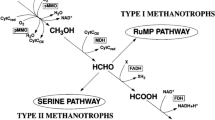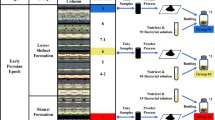Abstract
Radioisotopic measurements of the methane consumption by mud samples taken from nine Southern Transbaikal soda lakes (pH 9.5–10.6) showed an intense oxidation of methane in the muds of Lakes Khuzhirta, Bulamai Nur, Gorbunka, and Suduntuiskii Torom, with the maximum oxidation rate in the mud of Lake Khuzhirta (33.2 nmol/(ml day)). The incorporation rate of the radioactive label from14CH4 into14CO2 was higher than into acid-stable metabolites. Optimum pH values for methane oxidation in water samples were 7–8, whereas mud samples exhibited two peaks of methane oxidation activity (at pH 8.15–9.4 and 5.8–6.0). The majority of samples could oxidize ammonium to nitrites; the oxidation was inhibited by methane. The PCR amplification analysis of samples revealed the presence of genes encoding soluble and paniculate methane monooxygenase and methanol dehydrogenase. Three alkaliphilic methanotrophic bacteria of morphotype I were isolated from mud samples in pure cultures, one of which, B5, was able to oxidize ammonium to nitrites at pH 7–11. The data obtained suggest that methanotrophs are widely spread in the soda lakes of Southern Transbaikal, where they can actively oxidize methane and ammonium.
Similar content being viewed by others
References
Hanson, R.S. and Hanson, T.E., Methanotrophic Bacteria,Microbiol. Rev., 1998, vol. 60, no. 2, pp. 437–471.
Reeburg, W.S., Whalen, S.C., and Alperin, M.J., The Role of Methylotrophy in the Global Methane Budget,Microbial Growth on C1-Compounds, Murrell, J.C. and Kelly, D.P., Eds., Andover: Intercept Ltd., 1993, pp. 1–14.
Gal’chenko, V.F., Bacterial Methane Cycle in Marine Ecosystems,Priroda, 1995, no. 6, pp. 35–48.
Sokolov, A.P. and Trotsenko, Y.A., Methane Consumption in (Hyper)Saline Habitats of the Crimea (Ukraine),FEMS Microbiol. Ecol., 1995, vol. 8, no. 4, pp. 299–304.
Khmelenina, V.N., Starostina, N.G., Tsvetkova, M.G., Sokolov, A.P., Suzina, N.E., and Trotsenko, Yu.A., Methanotrophic Bacteria of the Saline Water Bodies of Ukraine and Tuva,Mikrobiologiya, 1996, vol. 65, no. 5, pp. 696–703.
Dedysh, S.N. and Panikov, N.S., Kinetics of Methane Oxidation in Sphagnous Peat as a Function of pH, Temperature, and Salt Concentration,Mikrobiologiya, 1997, vol. 66, no. 4, pp. 569–573.
Dunfield, P., Knowles, R., Dumont, R., and Moore, T.R., Methane Production and Consumption in Temperate and Subarctic Peat Soils: Response to Temperature and pH,Soil Biol. Biochem., 1993, vol. 25, no. 3, pp. 321–326.
Jones, B.E., Grant, W.D., Collins, N.C., and Maatha, W.E., Alkaliphiles Diversity and Identification,Bacterial Diversity and Systematics, Priest, F.G.et al., Eds., New York: Plenum, 1994, pp. 195–228.
Zhilina, T.N. and Zavarzin, G.A., Alkaliphilic Anaerobic Community at pH 10,Curr. Microbiol., 1994, vol. 29, pp. 109–112.
Zavarzin, G.A., Zhilina, T.N., and Pikuta, E.V., Secondary Anaerobes in the Haloalkaliphilic Communities of Tuva Lakes,Mikrobiologiya, 1996, vol. 65, no. 4, pp. 546–553.
Namsaraev, B.B., Zhilina, T.N., Kulyrova, A.V., and Gorlenko, V.M., Bacterial Production of Methane in the Southeastern Transbaikal Soda Lakes,Mikrobiologiya, 1999, vol. 68, no. 5, pp. 683–688.
Khmelenina, V.N., Kalyuzhnaya, M.G., Starostina, N.G., Suzina, N.E., and Trotsenko, Y.A., Isolation and Characterization of Halotolerant Alkaliphilic Methanotrophic Bacteria from Tuva Soda Lakes,Curr. Microbiol., 1997, vol. 35, no. 5, pp. 1–5.
Kalyuzhnaya, M.G., Khmelenina, V.N., Suzina, N.E., Lysenko, A.M., and Trotsenko, Yu.A., Novel Methanotrophic Isolates from the Southern Transbaikal Soda Lakes,Mikrobiologiya, 1999, vol. 68, no. 5, pp. 689–697.
Sorokin, D.Yu., About the Possibility of Nitrification under the Highly Alkaline Conditions of Soda Biotopes,Mikrobiologiya, 1998, vol. 67, no. 3, pp. 404–408.
Lee, S.Y., Bolinger, J., Bezdicek, D., and Ogram, A., Estimation of the Abundance of an Uncultured Soil Bacterial Strain by a Competitive Quantitative PCR Method,Appl. Environ. Microbiol., 1996, vol. 62, no. 10, pp. 3787–3793.
Murrell, J.G., McDonald, J.R., and Burne, D.O., Molecular Methods for the Study of Methanotroph Ecology,FEMS Microbiol. Ecol., 1998, vol. 27, no. 2, pp. 103–114.
Gal’chenko, V.F., Andreev, L.V., and Trotsenko, Yu.A.,Taksonomiya i identifikatsiya obligatnykh metanotrofnykh bakterii (Taxonomy and Identification of Obligately Methanotrophic Bacteria), Kalakutskii, L.V., Ed., Pushchino: Nauchn. Tsentr Biol. Issled. Akad. Nauk SSSR, 1986, p. 96.
Graham, D.W., Chaudhary, J.A., Hanson, R.S., and Arnold, R.G., Factors Affecting Competition between Type I and II Methanotrophs in Two-Organism, Continuous-Flow Reactors,Microb. Ecol., 1993, vol. 25, pp. 1–17.
Joye, S.B., Connell, T.L., Miller, L.G., Oremland, R.S., and Jellison, R.S., Oxidation of Ammonia and Methane in an Alkaline, Saline Lake,Limnol. Oceanogr., 1999, vol. 44, pp. 178–188.
Sorokin, D.Y., Jones, B.E., and Kuenen, J.G., A Novel Obligately Methylotrophic, Methane-oxidizingMethylomicrobium Species from a Highly Alkaline Environment,Extremophiles, 2000 (in press).
Manual of Methods for General Bacteriology, Gerhardt, P.et al., Eds., Washington: Am. Soc. Microbiol., 1981. Translated under the titleMetody obshchei bakteriologii, Moscow: Mir, vol. 2, pp. 341–350.
Dedysh, S.N., Liesack, W., Khmelenina, V.N., Suzina, N.G., Trotsenko, Y.A., Semrau, J.D., Abing, A.M., Panikov, N.S., and Tiedje, J.M.,Methylocella palustris gen. nov., sp. nov., a New Methane-oxidizing Acidophilic Bacterium from Peat Bogs Representing a Novel Subtype of Serine Pathway Methanotrophs,Int. J. Syst. Evol. Microbiol., 2000, vol. 50, no. 3, pp. 955–969.
Author information
Authors and Affiliations
Rights and permissions
About this article
Cite this article
Khmelenina, Y.N., Eshinimaev, B.T., Kalyuzhnaya, M.G. et al. Potential activity of methane and ammonium oxidation by methanotrophic communities from the soda lakes of southern Transbaikal. Microbiology 69, 460–465 (2000). https://doi.org/10.1007/BF02756771
Received:
Issue Date:
DOI: https://doi.org/10.1007/BF02756771




